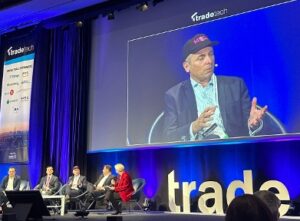As technological tools continue to evolve at an ever-increasing pace, market participants are continuing to feel the pressure to decide on a strategy and future-proof their business to avoid being left behind.
 Daniel Leon, global head of trading, treasury management and global solutions at HSBC Asset Management highlighted that his firm’s approach has been in large part to outsource data “onboarding”.
Daniel Leon, global head of trading, treasury management and global solutions at HSBC Asset Management highlighted that his firm’s approach has been in large part to outsource data “onboarding”.
He explained that as HSBC AM continues to seek a single piece of screen real estate for traders, data organisation is a key area that need to be addressed. Namely, of managing the number of application programming interfaces (API) and user interfaces (UI).
“The big thing we’ve done and are almost successfully finished with is we’ve been able to outsource, let’s call it the ‘onboarding’ of our data. It’s one of the key things we need to deliver, because to have a proper dataset for trading you need to have the right data.
“If we don’t organise our data at the beginning, you have a nightmare. Now what we have is a virtual layer which allows us to access our data in a simple way, which for us is a really positive step.”
Read more: ‘Buy before build’ says UBS AM’s global trading head Lynn Challenger
When asked what’s holding investment firms back from outsourcing their data, Rob Lane, global head of business execution, low latency at LSEG explained that it was down to the significant magnitude of the task at hand and the inevitability of heavy costs.
Lane explained that these costs are present across the ecosystem, with investment firms in particular expected to spin an increasing number of plates: “There’s a lot of things that investment firms need to keep on top of. So again, there’s a cost of people […] it can be done and we see firms doing it to different degrees, but it’s a large task.”
Elsewhere, Leon highlighted that concerns around the cloud are also front of mind, “something where I would definitely like to see progress is how are we able to going to handle such a big amount of data on the cloud and. For me, that’s a big step.”
Jarrod Yuster, chief executive of Pico, added that aside from storage capacity, network and bandwidth capacity should not be forgotten.
“Data rates continue grow […] we’re starting to look at 400 gig in terms of network monitoring and network capacity. While network costs do continue to go down and the biggest costs are really around computer storage hardware, you also have to factor in transporting this data more and more.
“Clients want data from anywhere around the globe as well as within the cloud. Even in the last couple of years storage costs have come down substantially again through the cloud layer, basically they’re helping. Whether it’s on the buy-side, the sell-side or members like ourselves, it’s definitely there to help.”
Robin Mess, co-founder and chief executive of big xyt, also added that cloud is not the answer to everything, arguing that the industry must continue to focus on making data usable.
“You have to work your data. You have to you have to clean it all and then you have to solve the problem of the use case.
“I think we have plenty of data members out there and technology providers that capture data and make it available but clean data and aggregated data signalling is a big challenge and the industry will see plenty of innovation yet to come in the space.”
Speaking to this complexity, Leon highlighted that the pursuit of real-time intel remains a key consideration.
“You have to look at it in different ways. You have the post-trade data which is very important because you need to do your check, but even at the point of trading, you need to know what happened in the past. ‘When I did I do that?’ ‘What happened?’ ‘Who was good?’ You need to have the processing of the post-trade data and then you really get into the difficulty of what data you need elsewhere.
“You’re starting to have a certain layer of complexity because you need something on the spot, and that’s a different animal.”